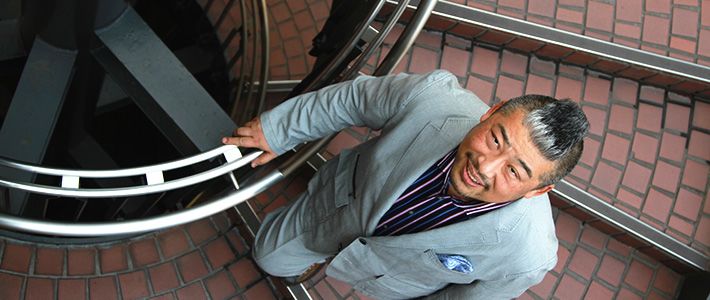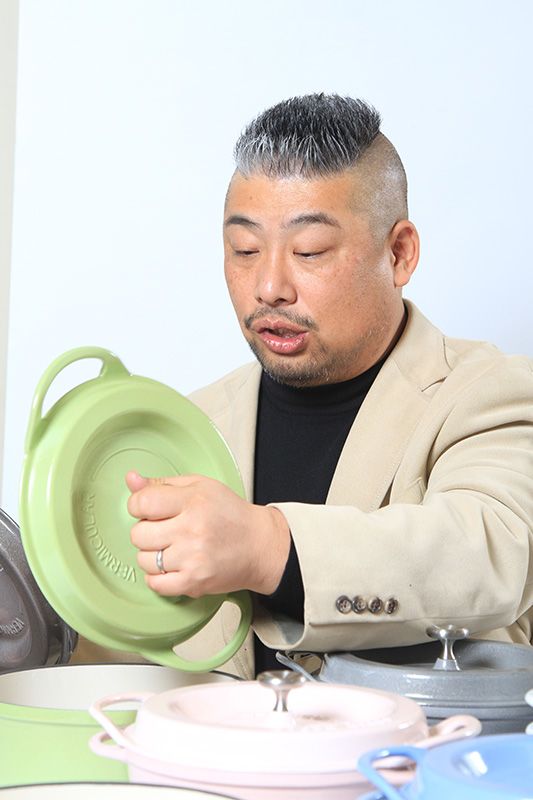
The Road to Hit Products by Kitamura Mori
The Essence of Product Journalism Is Being Skeptical
Economy Lifestyle- English
- 日本語
- 简体字
- 繁體字
- Français
- Español
- العربية
- Русский
 Kitamura Mori
Kitamura Mori
Born in Toyama Prefecture in 1966. Read the magazine Kurashi no techō as a young schoolchild and, awed by the thoroughness of the product tests in the articles, decided that magazine editing was his calling. Joined Nikkei Home Publishing in 1992 after graduating from Keiō University with a degree in law. Was involved in hotel accommodation checks and numerous other product tests as an editor for such periodicals as Nikkei Adole and Nikkei Trendy, and served as editor-in-chief of Nikkei Trendy from 2005 to March 2008. Since 2008, has actively been collecting stories around Japan, giving talks, and writing articles as a product journalist under the self-proclaimed mission of “evaluating everything that consumers can buy with their money.” Checks dozens of product samples and services every month and conducts inspections of hotels and restaurants in Japan and abroad. Teaches IT marketing in Cyber University, an online university founded by SoftBank and others.
Are “Dream” Products for Real?
INTERVIEWER I understand that a fateful encounter in your childhood made you decide that you wanted to be a magazine editor.
 KITAMURA MORI I grew up in the seventies, when the microwave oven hit the scene with loud fanfare. Around the time, the magazine Kurashi no techō ran top feature stories in successive issues in which it made dozens of microwave dishes. Many manufacturers were touting microwaves as the “dream cooker,” and expectations were high among homemakers that cooking would become easier and that they would be able to serve delicious food to their families. But the chief editor of Kurashi no techō, Hanamori Yasuji [1911–1978], cast doubt on these assumptions. He conducted checks based on just one question: Is the microwave oven really a dream cooker? The approach was simply to keep cooking. They would make dishes like sunny-side ups and simmered vegetables using a microwave, and compare them with the same dishes made with conventional implements, such as skillets and pots. The comparisons would be based on various factors, such as cooking time, gas consumption, electricity cost, and taste. A brief evaluation would then follow giving thumbs up or down on each point.
KITAMURA MORI I grew up in the seventies, when the microwave oven hit the scene with loud fanfare. Around the time, the magazine Kurashi no techō ran top feature stories in successive issues in which it made dozens of microwave dishes. Many manufacturers were touting microwaves as the “dream cooker,” and expectations were high among homemakers that cooking would become easier and that they would be able to serve delicious food to their families. But the chief editor of Kurashi no techō, Hanamori Yasuji [1911–1978], cast doubt on these assumptions. He conducted checks based on just one question: Is the microwave oven really a dream cooker? The approach was simply to keep cooking. They would make dishes like sunny-side ups and simmered vegetables using a microwave, and compare them with the same dishes made with conventional implements, such as skillets and pots. The comparisons would be based on various factors, such as cooking time, gas consumption, electricity cost, and taste. A brief evaluation would then follow giving thumbs up or down on each point.
The outcome was that the microwave got a thumbs down on most criteria. Sometimes the comment simply read, “Tastes bad.” The magazine stated flat out that, while the microwave may be convenient for heating cold rice, calling it a dream cooker was a lie. I thought, “Wow, I want to do so something like that in the future.”
Conducting Thorough Comparative Tests
INTERVIEWER There aren’t that many people who call themselves product journalists.
KITAMURA Contrary to what you might expect, product journalism is relatively new. Magazines rely on advertisements for nearly half of their revenues, making it difficult for them to objectively appraise good products as good and poor products as poor.
INTERVIEWER So most magazines couldn’t criticize products.
Precisely. I think there are many magazines that only say good things, and any criticisms they make are halfhearted. Nikkei Trendy was already practicing product journalism by the time I was assigned to it in 1994. There was an ongoing boom in luxury cars in Japan since the days of the economic bubble. In the early 1990s, the editorial team at the time asked Formula One driver Nakajima Satoru, who had recently retired at the height of his popularity, to drive the cars and evaluate every one of them. They had him verify that even the most expensive cars weren’t worthy of their luxury titles unless their performance was solid in hazard avoidance, agility, and braking. They tested dozens of cars. In another article a few years later, we compared imported cars to domestic cars by looking at factors such as maintenance costs, the sale price, and the car’s performance, all projected over a period of a few years. Car magazines and other journals followed suit.
Three Rules for Recognizing Good Products and Services
INTERVIEWER Tell us three rules for consumers to follow so as not to make mistakes.
 KITAMURA Number one: Never forget the anger you felt at a shopping mistake. People forget how angry they felt. And then they say, “Oops, here I go again, I’ve made another mistake.” You should be able to considerably lower the chances of another failed shopping experience simply by remembering how angry you were.
KITAMURA Number one: Never forget the anger you felt at a shopping mistake. People forget how angry they felt. And then they say, “Oops, here I go again, I’ve made another mistake.” You should be able to considerably lower the chances of another failed shopping experience simply by remembering how angry you were.
Number two: Don’t let the tag line fool you. Manufacturers only tout what they want to tout, and the products may not necessarily suit the interests of the consumer. What is important is whether it’s the consumers’ interests or corporate interests that take precedence in the development process. When doing stories, I always take note of which is prioritized when a narrow decision has to be made between the two. This could be related to areas such as the cost, the production methods, the finish, the price, the product’s performance, or its functionality.
Number three: Know that there is a reason behind every price. Excessively cheap products will have problems one way or another. Every price has a reason.
Fortunately, consumers are beginning to realize this too. Expensive products cost what they do because their quality is correspondingly high, and nowadays consumers tend to buy products in that range if it means the product will last longer.
Defining the Axes of Evaluation
INTERVIEWER How, specifically, do you conduct comparative evaluations of products?
KITAMURA We grade home appliances and digital products on a scale of A to C, a little bit like the Michelin Guide’s three star rating system.
After comparing the products under the assumption that it’s about time for a replacement, we give a B to products that are good enough to be an option and a C to those that you shouldn’t buy because of a fatal flaw. Products that are worth buying even if you have to throw out what you currently own get an A.
When looking at new products, I’ve always made a point of clearly defining the axes of evaluation. In my mind, that’s where the value of product journalism lies. Comprehensive product reviews are confusing to consumers and are, in fact, pointless.
With compact digital cameras, you see the biggest difference in dimly lit conditions, when the camera shakes, and with photos of people. The best opportunities to test this triple challenge are parties at restaurants or bars. There are lots of people, and on top of hand movement, the photographer is drunk and unsteady. Plus, it’s dim. Under these conditions, you see immense differences between models that let you take good pictures and those that don’t. So that’s where you need to do the tests.
Three Points for Developing Products That Surprise Consumers
INTERVIEWER How would you like manufacturers to approach product development?
KITAMURA The worst kinds of products are those that play to the consumer. Interviewing consumers and picking up their preferences may seem like a way of respecting the consumers’ convenience. But even if a manufacturer were to ask consumers what they want and make a product accordingly, there’s no way this will result in the right answer. The market-in approach—or the interactive approach or consumer-participation approach, as it is variously called—cannot create mega hits. A very wide gulf exists between the maker and buyer.
The second thing I would ask of manufacturers is to not underestimate consumers. They will suffer a backlash if they do, because although consumers may be insecure, at times they can be extremely sharp.
The third thing I would say to manufacturers is to not lose their way searching for consumers. A case in point is Sony’s slump in recent years. My guess is that Sony has lost track of what consumers are looking for. Although, admittedly, some parts of the company are putting up a good fight, as seen in the success of its bicycle navigation system.
I’ve been thinking about what that stance translates to—of not playing to consumers, not underestimating consumers, and not losing one’s way searching too hard for what consumers are looking for—and I’ve finally found the answer. It’s a stance of surprising consumers.
To achieve that, I think there are three marketing approaches. The first is to create products that make people say, “No way!” For instance, Ito En came out with the world’s first green tea in plastic bottles in 1990. Initially, people were surprised and thought, “No way! You can’t put green tea in plastic bottles and expect it to sell.” But nowadays green tea beverages have grown to comprise a huge part of the market for nonalcoholic beverages.
The second approach is to draw the response, “Who’d go that far?” Some examples are the all-out services offered by the Tokyo Disney Resort cast [staff] and those of the Ritz-Carlton hotels in Tokyo and Osaka.
The third approach is to do things that will get competitors exclaiming in chagrin, “I knew it!” That is, to catch competitors off guard. Mazda’s new Demio [marketed as Mazda 2 overseas] is an “eco car” that achieves hybrid-level mileage with a gasoline engine. It was something that everyone in the automobile industry anticipated, but when Mazda seriously set out to develop a car like that, it became a big hit.
Tenacity Leads to Hit Products
INTERVIEWER These days, I hear of small and medium-sized local businesses becoming quite successful with products that they developed as a last resort in their search for ways to stay afloat.
KITAMURA These businesses are exploiting gaps in areas where leading manufacturers are slacking off. Take, for example, the multispeed mixers developed by Yamamoto Electric Corporation of Fukushima Prefecture. Major manufacturers had abandoned efforts to improve on food processors, which they assumed had evolved as far as they could go. Here Yamamoto Electric, which specializes in motors, made its full-scale entry and came out with incredibly user-friendly products.
The Vermicular brand of pots produced by Aichi Dobby is also very popular, with a current wait of over a year. Even major companies couldn’t come up with technologies for enamel coated cast iron products like the French brand Le Creuset. But a small Nagoya-based manufacturer spent a year tenaciously developing them.
 Kitamura describes the appeal of the immensely popular Vermicular pot.
Kitamura describes the appeal of the immensely popular Vermicular pot.
This tenacity is what’s important. A food sanitation inspection company in Tokushima Prefecture took a year to develop a way of freezing raw nori [seaweed] in the desperate desire to deliver to consumers the taste of nori just gathered by local harvesters. The outcome was a product called Ikiteiru Nori [Living Seaweed]. It’s a technology that a large manufacturer could have developed more quickly by sheer force of numbers.
INTERVIEWER It’s said that the world can see the shape of Japan through Japanese product development. In your reporting trips around Japan, have you encountered products that you felt you wanted to introduce to the world?
KITAMURA Yes, quite often. Japan has led the world in cutting-edge technologies, but what’s really interesting right now is that timely products are born by further pursuing and honing existing technologies. The products that I would like to introduce aren’t digital products representing Japan’s high tech but products illustrating how you can get breathtakingly exciting results when you perfect technologies and make products with attention to detail. Tools that add to the quality of life and everyday goods that make you say “Aha!” are coming out one after another, and sometimes these products enrich Japanese lives. Behind them are the tales of incredible concentration and the tenacity of creators who passionately track down problems, never giving up. I would very much like to share these tales with people around the world.
(Translated from an April 13, 2012, interview in Japanese. Interviewer Harano Jōji is representative director of the Nippon Communications Foundation. Photos by Kawai Satoshi.)
Kitamura Mori Nikkei Trendy microwave Nakajima Satoru consumers manufactures Ito En product Mazda Yamamoto Electric Corporation Aichi Dobby Vermicular Ritz-Carlton Le Creuset